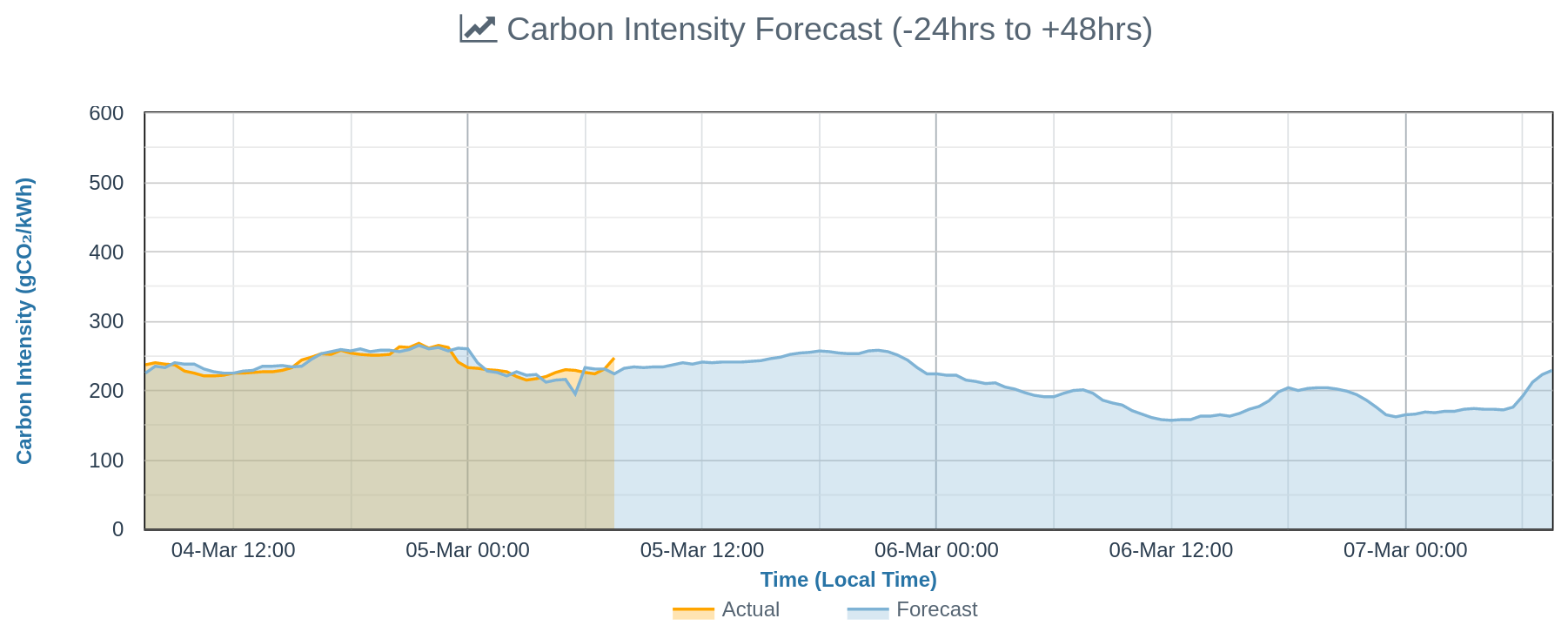Modern societies function in large part thanks to our ability to use as much electricity as we want, when we want it. As renewable energy (solar, wind) plays a greater part in the electricity generation mix, our opportunities to use “cleaner” energy increase, but renewables are also fickle — sometimes the wind doesn’t blow, and the sun doesn’t shine. Today in the UK, for example, the weather is overcast and still: solar and wind aren’t going to generate much power. In such cases, the electricity we’re using is generated from much “dirtier” sources.
For the last 6 months or so, I’ve been trying to see what I can do to increase the “clean” proportion of electricity I use. I have a lot of limiting factors: I can’t, for example, install solar panels or a wind turbine. But what I can do is change when I use electricity.
My intention is not for or me (or my family!) to live like a stylite or troglodyte: personally, I rather like the conveniences and comfort of modern life. Therefore, there are lots of things where my timings are inflexible — I’m not going to turn the oven on to produce a meal at midnight, nor am I going to switch my computer off when there’s a big football match on.
However, there are several things where my timings are flexible. I’m going to use my washing machine as an example (the same principle applies to e.g. dishwashers, tumble dryers, and the like). I often need to make sure something is washed by a certain time, but it doesn’t matter if I wash it right now or just before the point that I need it to have been washed.
Since I know that peak energy usage tends to be from around 16:00-19:00 each day, I guessed that’s the “dirtiest” time of the day to use electricity and I avoided running my washing machine then. After a little more thought, I guessed that not many people are using electricity early in the morning, so I scheduled the washing machine to come on at about 06:00. I guessed that this was early enough to have some benefit from a power generation perspective, but just late enough that the (potentially noisy!) spin cycle wouldn’t occur until our neighbours are awake.
However, you’ll notice that I was doing quite a lot of guessing. I also recently realised that my assumptions were largely based on wind power, which is the main renewable source in the UK in winter. It’s a reasonable guess that wind power is fairly evenly spread over 24 hours but as spring arrives, solar power is going to become more important, and that’s clearly highly unevenly spread throughout the day. How should I factor that in?
I was thus very pleased a few weeks back to stumble across the UK Carbon Intensity forecasting site. At first my internal programmer was attracted by the “API” part of the site, but I soon realised that this site is useful for more normal activities. It provides a 48 hour forecast of how carbon intensive (a tighter definition than the wishy-washy “clean” I’d been using until now) energy usage will be.
If you scroll down about halfway (I wish this was at the top of the site!) you can see the current forecast:

On the x-axis we have time and on the y-axis carbon intensivity (lower is better). The left-hand one third of the graph (in off white) shows the previous 24 hours, matching the forecast to the reality. The right-hand two thirds of the graph show the forecast. As this shows, today’s overcast, still weather in the UK means that electricity usage is very carbon intensive but tomorrow, as wind speeds pick up as the morning goes on, carbon intensivity declines noticeably, hitting a trough at midday.
What I like about this forecast is how simple it is to read. Currently I need to have washed a load of towels before Friday. I could wash them today, but that would be foolish when I could do so tomorrow at much lower carbon intensivity. So tomorrow, around 11:30, you will find me feeding a load of towels into my washing machine. Not only is this easier than scheduling an early morning wash, but I don’t have to worry about the spin cycle disturbing anyone’s sleep!
Of course, just me changing my energy usage patterns doesn’t make much difference: backup (carbon intensive) electricity generation will still be active whatever I do. And, perhaps, one day in the future we’ll have access to as much carbon neutral energy as we want.
However, in the here and now, the forecasting site allows those of us who have the ability, whether at home or at work, to shift our energy usage a bit to see if we can also shift the collective needle a bit. It also shows the power of a neat little website with a simple graph — I just hope they move the main graph to the top of the site soon! And, of course, the UK forecasting site is only relevant for those of us in the UK — are there equivalents for other countries? If you know of any, please feel free to leave a comment below!